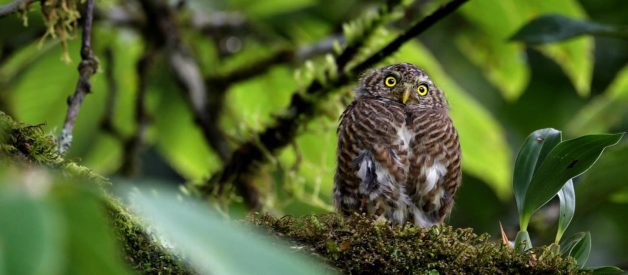
Owls are solitary creatures, who sleep all day and prowl at night. Owls evoke extreme feelings. Either they send a creepy shudder through the spine or make people open their eyes wide in wonder. Among birds they enjoy an enviable status. Owls are perhaps the only birds that have captured the imagination of the humans throughout the centuries. Since, owls are rarely seen during the day, the most prevalent image of the owls is that which associate it with the dark. And indeed their haunting gaze and creepy hoot further cements this factor. Unfortunately, this also gave rise to indiscriminate killing to ward off the ?evil eye? and also its use in various rituals.

The days preceding the Dussehra and Diwali festivals are terrible for these nocturnal creatures. During this period owl trade is rampant, with the birds being sold at a premium in illicit bazaars. During Kali Puja, business communities in Bengal sacrifice owls to gain wealth.

There are mixed interpretations of the bird. Some feel that sighting an owl brings luck whereas some feel that it?s a sign of bad omen. However, one common observation has been that a white owl brings luck, whereas any other owl is a sign of bad omen. Owls also have their association with things dark and sinister and death. Popular representations have associated an owl with the cemetery and the hoot of an owl is always associated with spooky feelings, and sometimes as harbingers of death.

Members of the Garo Tribe of Meghalaya, call owls dopo or petcha. Along with nightjars, they also refer to owls as doang, which means birds that are believed to call out at night when a person is going to die.
It is very common to call a foolish person ?an owl.? But in mythology the owl has been treated at times reverently and given some place of prestige. For instance, Laxmi, the Hindu goddess of money and wealth, rides an owl. Some people believe that if a white owl enters a home it is treated as a good omen by relating it to the possible flow of wealth or money into that home. It is also believed that the owls have magical properties which can ward off bad luck.

However, because of their nocturnal activity and screeching call, they have been associated with bad luck and death, and are believed to be Alakshmi?s (Lakshmi?s elder twin) savari, the goddess of strife and misfortune.
Because of its round eyes that never move and stare straight ahead, the owl has been associated with wisdom. The term ?lord with circular eyes? (Choka-dola) is used to refer to Jagannath, the form of Krishna-Vishnu worshipped in Puri.
The beliefs of Shakun and Apshakun are age old. According to Shakun shastra, certain signs of owls indicate good news and some other signs indicate bad news.
- If a person who is travelling hears an owl?s voice saying ?hom-hom?, it indicates good news.
- If an owl starts coming to one house again and again, that house gets destroyed or the owner of the house faces some problems.
- If an owl sits on top of a house and makes sounds, it indicates death in the family.
- If an owl cries in front of someone?s door for three days, it indicates that there is going to be a robbery in the house or inmates will face money problems.
- Seeing an owl on the left side or hearing its voice from the left side is auspicious; while its opposite is inauspicious.
- If an owl is seen behind a guest, it indicates good news work wise.
An Owl is a very intriguing bird. Besides, its nocturnal habits, it is also supposed to be amongst the oldest of the vertebrate animals in existence as fossils dated back to more than sixty million years back have been found.
The Brown Wood Owl, Forest Eagle-owl, and the Brown Fish Owl are found in dense riparian forests of Ficus near streams and ponds, sites often considered as sacred groves, or in cemeteries that bear the last of the largest trees with cavities and hollows in an area. Old-forest owls, particularly the Forest Eagle-owl, play major roles in many Nepali, and Hindu legends. As heard calling at night from cemeteries and sacred groves, such owls are thought to have captured the spirit of a person departed from this world. In one sense, many of these owl species can serve as indicators of the religious value of a forest; conserving the religious site equally conserves key roost or nest sites.
The Forest Eagle-owl is known to take peafowl, junglefowl, hares, jackals, and even young barking deer. Its cry is a low, deep, and far-sounding moaning hoot and a blood-curdling shriek as of a woman in grief, earning this creature the name of ?Devil Bird.? This Devil Bird or Devil Owl is found in graveyards and big dead trees and the eerie cries of the Devil Owl portend death. The Muslims revere everything in a cemetery including the vegetation. And here converge myth, culture, and biology for a successful conservation of cultures, people, and wildlife.
The Spotted Owl has other cousins that have been, or can be, used to indicate the health of the vanishing ancient forests of the world. For example, in the greater Indian subcontinent ranges the Brown Wood Owl, which likewise inhabits mostly old and lesser disturbed Sal forests; while the Bay Owl residing in the Himalayas is a rare denizen and indicator of dense evergreen submontane forests of cedar and other conifers.
Fortunately, to stop fast breeding of rodents we have a variety of owls residing close to human habitation and playing a pivotal role in protecting us from diseases and save food grains stored in houses and granaries. It is estimated that almost 30 per cent of agricultural produce in the country is lost to the marauding rats.
Owls fortunately provide a free service of eradicating rodents for human beings. Around 30 varieties of owls are equipped with glaring eyes with a dash of bright yellow. They have sharp vision with eyeballs placed in a front facing head to specifically scan and ?peel? open even inky nights to find rats, lizards and snakes. These erudite eyes of the owl have stereoscopic visualisation for nocturnal ambush.
Some Interesting Facts
- Owls can be found throughout the world, except Antarctica. They are found in a variety of habitats, from grasslands to deserts to snow covered landscape to dense forests.
- In owls, the females are generally larger than the males.
- There are over 150 species of owls in the world.
- Since, owls cannot move their eyes, they have to move their entire head to look around. Owls can turn their head to 180 degrees. This is possible because owls have an extra vertebra in their spine.
- The colour of the pupils of the eyes of the owls indicates the time they hunt. The owls having yellow eyes hunt during the day, those with dark eyes hunt during the day, and those with orange eyes hunt during the dawn and dusk.
- Owls do not have the sense of smell as well as the sense of taste.
- The ears of owls are not aligned evenly and so their sense of hearing is enhanced. They can even hear their prey moving beneath the snow and also hunt in complete darkness.
- Owls pair for life.
- The smallest owl is the Elf Owl which can grow up to 5 inches. The largest are the two Eagle Owls that can grow up to 29 inches with a wing span of 6 feet.
- A group of owls is known as a parliament, though most owls tend to be solitary.


